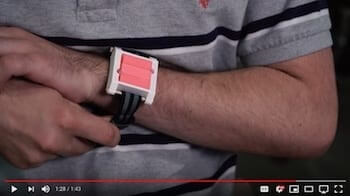Apr 18
2019
Rice Students Develop Wearable To Halt Allergic Reactions
 What if, in an emergency, you reach for your epinephrine shot and it’s not there? It would be if you were wearing it.
What if, in an emergency, you reach for your epinephrine shot and it’s not there? It would be if you were wearing it.
Rice University students have designed a small, foldable epinephrine delivery device meant to be worn on a wrist, like a watch, or elsewhere on the body by a person at risk of an allergic reaction that requires an immediate response.
The tri-fold device they call EpiWear has a unique, spring-activated injection system that would provide a full dose of the drug to a person experiencing an allergic reaction.
The team – junior bioengineering majors Albert Han, Alex Li, Jacob Mattia and Justin Tang, and freshman Callum Parks – said the device is intended for all but small children, and could be a good alternative to other delivery systems on the market.
“The idea came from me, because I suffer peanut allergies,” said Tang, who worked on the device at the Brown School of Engineering‘s Oshman Engineering Design Kitchen with adviser and Rice lecturer Deirdre Hunter. “I’m very self-aware and worried about my life, but it was always difficult for me to bring something as bulky and obtrusive as this when going to dinner with friends or just going out at night.”
Tang held up the pen-like syringe he carries in case of emergency. Such pens were the focus of controversy a few years ago when Congress held a hearing on the sharply rising price of the devices.
The Rice team hopes its creation will lead to a delivery device that is less expensive, more stylish and thus more likely to be worn by users.
“We designed the optimal device to house the minimal amount of epinephrine necessary for injection,” Mattia said, holding a scaled-up prototype.
EpiWear is designed to inject a dose of 0.3 milliliters of epinephrine, the same as commercial devices that contain more of the drug.
“They actually only inject a fraction of what they hold,” Li said.